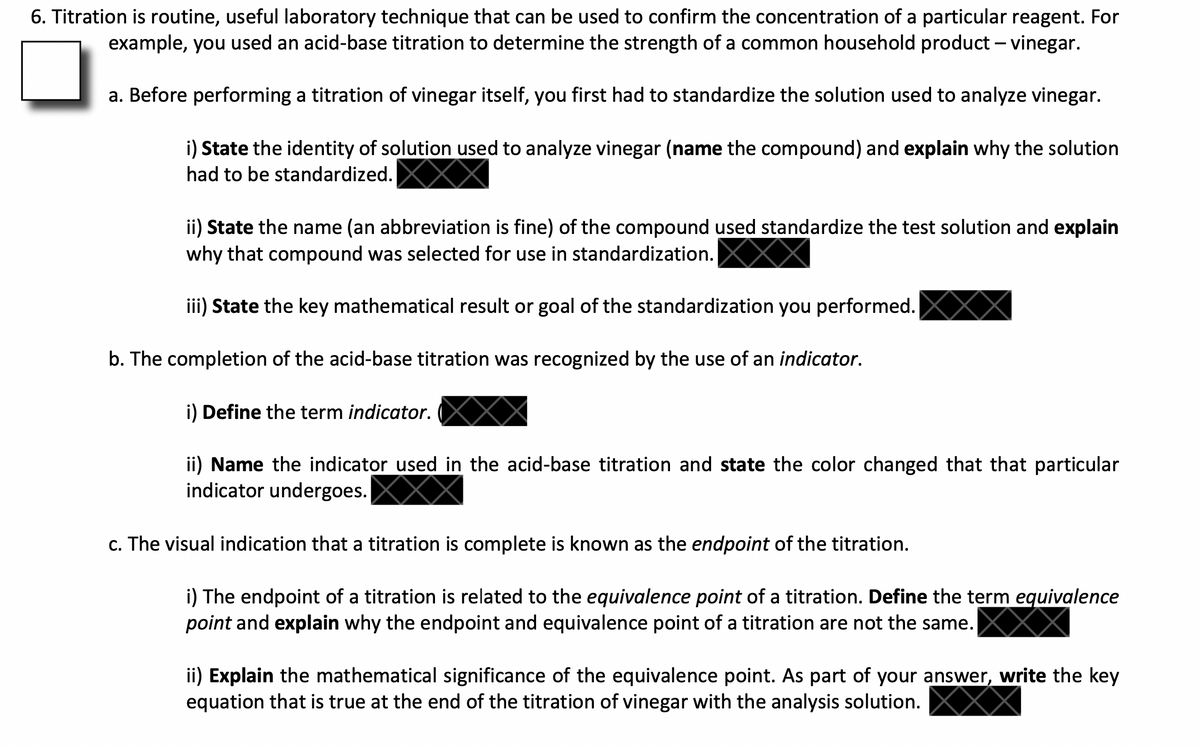Titration is routine, useful laboratory technique that can be used to confirm the concentration of a particular reagent. For example, you used an acid-base titration to determine the strength of a common household product – vinegar. a. Before performing a titration of vinegar itself, you first had to standardize the solution used to analyze vinegar. i) State the identity of solution used to analyze vinegar (name the compound) and explain why the solution had to be standardized. ii) State the name (an abbreviation is fine) of the compound used standardize the test solution and explain why that compound was selected for use in standardization. iii) State the key mathematical result or goal of the standardization you performed.
Titration is routine, useful laboratory technique that can be used to confirm the concentration of a particular reagent. For example, you used an acid-base titration to determine the strength of a common household product – vinegar. a. Before performing a titration of vinegar itself, you first had to standardize the solution used to analyze vinegar. i) State the identity of solution used to analyze vinegar (name the compound) and explain why the solution had to be standardized. ii) State the name (an abbreviation is fine) of the compound used standardize the test solution and explain why that compound was selected for use in standardization. iii) State the key mathematical result or goal of the standardization you performed.
World of Chemistry, 3rd edition
3rd Edition
ISBN:9781133109655
Author:Steven S. Zumdahl, Susan L. Zumdahl, Donald J. DeCoste
Publisher:Steven S. Zumdahl, Susan L. Zumdahl, Donald J. DeCoste
Chapter15: Solutions
Section: Chapter Questions
Problem 63A
Related questions
Question

Transcribed Image Text:6. Titration is routine, useful laboratory technique that can be used to confirm the concentration of a particular reagent. For
example, you used an acid-base titration to determine the strength of a common household product – vinegar.
a. Before performing a titration of vinegar itself, you first had to standardize the solution used to analyze vinegar.
i) State the identity of solution used to analyze vinegar (name the compound) and explain why the solution
had to be standardized.
ii) State the name (an abbreviation is fine) of the compound used standardize the test solution and explain
why that compound was selected for use in standardization.
iii) State the key mathematical result or goal of the standardization you performed.
b. The completion of the acid-base titration was recognized by the use of an indicator.
i) Define the term indicator.
ii) Name the indicator used in the acid-base titration and state the color changed that that particular
indicator undergoes.
c. The visual indication that a titration is complete is known as the endpoint of the titration.
i) The endpoint of a titration is related to the equivalence point of a titration. Define the term equivalence
point and explain why the endpoint and equivalence point of a titration are not the same.
ii) Explain the mathematical significance of the equivalence point. As part of your answer, write the key
equation that is true at the end of the titration of vinegar with the analysis solution.
Expert Solution
This question has been solved!
Explore an expertly crafted, step-by-step solution for a thorough understanding of key concepts.
This is a popular solution!
Trending now
This is a popular solution!
Step by step
Solved in 2 steps

Knowledge Booster
Learn more about
Need a deep-dive on the concept behind this application? Look no further. Learn more about this topic, chemistry and related others by exploring similar questions and additional content below.Recommended textbooks for you

World of Chemistry, 3rd edition
Chemistry
ISBN:
9781133109655
Author:
Steven S. Zumdahl, Susan L. Zumdahl, Donald J. DeCoste
Publisher:
Brooks / Cole / Cengage Learning

Principles of Modern Chemistry
Chemistry
ISBN:
9781305079113
Author:
David W. Oxtoby, H. Pat Gillis, Laurie J. Butler
Publisher:
Cengage Learning


World of Chemistry, 3rd edition
Chemistry
ISBN:
9781133109655
Author:
Steven S. Zumdahl, Susan L. Zumdahl, Donald J. DeCoste
Publisher:
Brooks / Cole / Cengage Learning

Principles of Modern Chemistry
Chemistry
ISBN:
9781305079113
Author:
David W. Oxtoby, H. Pat Gillis, Laurie J. Butler
Publisher:
Cengage Learning


Chemistry: An Atoms First Approach
Chemistry
ISBN:
9781305079243
Author:
Steven S. Zumdahl, Susan A. Zumdahl
Publisher:
Cengage Learning

Chemistry
Chemistry
ISBN:
9781305957404
Author:
Steven S. Zumdahl, Susan A. Zumdahl, Donald J. DeCoste
Publisher:
Cengage Learning

General Chemistry - Standalone book (MindTap Cour…
Chemistry
ISBN:
9781305580343
Author:
Steven D. Gammon, Ebbing, Darrell Ebbing, Steven D., Darrell; Gammon, Darrell Ebbing; Steven D. Gammon, Darrell D.; Gammon, Ebbing; Steven D. Gammon; Darrell
Publisher:
Cengage Learning